This blog was originally published on the web site Sixties City where you can find more information about Swinging London! It doesn’t include some of the legendary folk venues like Bungie’s and Les Cousins but it certainly gives a comprehensive background to British Jazz , Rock & Roll and Mod culture. It’s interesting to note how short lived some of these places were but had a significant long term impact. This is also true for the many coffee bars in my home town of Leicester that were imitations of the London trend but had a massive influence on the local live music scene with places like the Green Bowler, the Nite Owl, The Chameleon and the Casino Ballroom.
A couple of years back I visited the Casbah Coffee Club in Liverpool where the Beatles started.When it was opened it was based on the 2is Coffee Bar in London where most of the early British Rock & Rollers played. It is incredibly well preserved and gives a real insight into the Coffee Bar trend of the 60s. The fact there was no alcohol served meant they could open when they wanted, even all night, and created a real live culture that was full of confidence and cultural aspiration. This is where the success of the British music industry was really established.
Of particular interest to me was the club called the Scene which obviously became the template for many similar clubs around the country during the height of the Mod era. Like them it was very short lived but shone with an intense and powerful light during it’s existence. Until relatively recently I knew nothing about this club but all the regular acts like Georgie Fame and his Blue Flames, The Graham Bond Organisation and Geno Washington and his Ram Jam Band also played often at the Nite Owl and probably many other clubs up and down the country.
Soho occup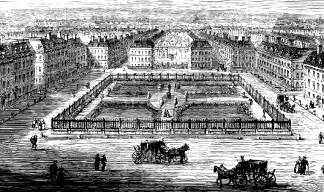 ies an area of London about a square mile in size whose boundaries are generally accepted as being Oxford Street to the north, Leicester Square to the south, Charing Cross Road to the east and Regent Street to the west and includes the area known as ‘Chinatown’ which sits between Leicester Square and Shaftesbury Avenue. These are fairly modern delineations as the original area has never been formally identified, either geographically or administratively. To the north of it is Fitzrovia, with St. James’s to the south, Covent Garden to the east and St. Giles and Mayfair to the west.
ies an area of London about a square mile in size whose boundaries are generally accepted as being Oxford Street to the north, Leicester Square to the south, Charing Cross Road to the east and Regent Street to the west and includes the area known as ‘Chinatown’ which sits between Leicester Square and Shaftesbury Avenue. These are fairly modern delineations as the original area has never been formally identified, either geographically or administratively. To the north of it is Fitzrovia, with St. James’s to the south, Covent Garden to the east and St. Giles and Mayfair to the west.
The area was open agricultural and grazing land in the Middle Ages, when it was owned by the Abbott and Convent of Abingdon and the Master of the Hospital of Burton St.Lazer (also the custodian of the Leper Hospital of St.Giles), until it was ‘acquired’ by Henry VIII, during the dissolution of the monasteries in 1536, for use as a royal park attached to the Palace of Whitehall.
The name of the area ‘Soho Fields’ seems to have first come into use during the early part of the 17th century and is believed to originate, for whatever reason, from an old hunting cry, which is not unlikely as the area had probably been used for ‘royal hunts’ during that period. The cry of ‘Soho!’ is certainly known to have been used as a rallying call in the Battle of Sedgemoor at the end of the Monmouth Rebellion in 1685, many years after being adopted into general use for the London area.
Some of the land passed from the crown to the 1st Earl of St. Albans, Henry Jermyn, in the mid-1600s, and 19 acres of it was subsequently leased to brewer Joseph Girle who acquired building permission for the land before passing on the lease to Richard Frith in 1677. Frith, a bricklayer by trade, initiated the major construction in the area.
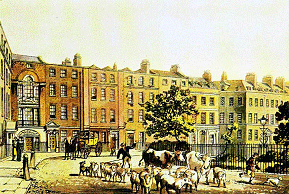 The land to the south, that was to become the parish of St. Anne, was gradually sold off by the crown in parcels during the 16th and 17th centuries, some of which was acquired by Robert Sidney, the Earl of Leicester. Freehold of the bulk of the area was granted to William, Earl of Portland, by King William III in 1698. The intention of the various landowners was to try and develop the area in the same way as nearby Marylebone, Mayfair and Bloomsbury but, although attracting a few aristocrats to the likes of Soho Square and Gerrard Street, it failed to retain any long-standing popularity as a residence with the rich of the country. It did, however, attract immigrants, particularly French Calvinist Huguenots, that led to it becoming known as ‘The French Quarter’ in the latter part of the 17th century.
The land to the south, that was to become the parish of St. Anne, was gradually sold off by the crown in parcels during the 16th and 17th centuries, some of which was acquired by Robert Sidney, the Earl of Leicester. Freehold of the bulk of the area was granted to William, Earl of Portland, by King William III in 1698. The intention of the various landowners was to try and develop the area in the same way as nearby Marylebone, Mayfair and Bloomsbury but, although attracting a few aristocrats to the likes of Soho Square and Gerrard Street, it failed to retain any long-standing popularity as a residence with the rich of the country. It did, however, attract immigrants, particularly French Calvinist Huguenots, that led to it becoming known as ‘The French Quarter’ in the latter part of the 17th century.
After the revocation of the Edict of Nantes in 1685 around 15,000 Huguenots fled France to avoid the religious persecution and by 1711 almost half of the parish of Soho was French. There is still a French Protestant church at 8/9 Soho Square that they founded in 1891 – 1893.
Developed during the late 1670s, Soho Square was a very fashionable place to live in its early years. It was originally called King’s Square in honour of Charles II and a statue of the king, created by Danish sculptor Caius Gabriel Cibber, was the centre piece of the Square in 1681, atop a fountain whose four spouts represented the rivers Thames, Severn, Tyne and Humber. . It was removed during alterations to the square in 1875 and eventually placed on an island in a lake at Grim’s Dyke, where it remained until 1938 when it was restored to its present location. Its name was changedfrom King’s Square to Soho Square sometime after 1739 and two of the original houses, numbers 10 and 15, still remain. The British Board of Film Censors (now The British Board of Film Classification) was created in 1912 by the film industry, who much preferred to retain regulation of their own censorship rather than have the government do it for them, and established itself in Soho Square.
Frith Street, named after developer Richard Frith, was built around 1680. In the 18th and early 19th centuries the Bohemian influence of the area was increased by the artists, writers and other historical notables who were born, died or moved into the area in general and in this street in particular. Legal reformer Samuel Romilly was born at number 18 in 1757.
B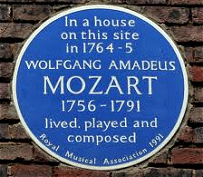 etween 1764-5 Wolfgang Amadeus Mozart, together with his sister and father lodged at number 20. Painter John Alexander Gresse was here in 1784 (the year he died) and John Horne Tooke (a philologist and political figure) and artist John Constable lived here in the first decade of the 1800s. Actor William Charles Macready was living at number 64 in 1816 and essayist William Hazlitt lodged and wrote at number 6 until his death in 1830. Sculptor John Bell resided here in 1832-33 and lithographic artist Alfred Concanen worked out of a studio at number 12 for many years.
etween 1764-5 Wolfgang Amadeus Mozart, together with his sister and father lodged at number 20. Painter John Alexander Gresse was here in 1784 (the year he died) and John Horne Tooke (a philologist and political figure) and artist John Constable lived here in the first decade of the 1800s. Actor William Charles Macready was living at number 64 in 1816 and essayist William Hazlitt lodged and wrote at number 6 until his death in 1830. Sculptor John Bell resided here in 1832-33 and lithographic artist Alfred Concanen worked out of a studio at number 12 for many years.
In the 20th century, John Logie Baird lived and ran his laboratory at number 22 (now occupied by Bar Italia) where, on 26th January 1926, he first demonstrated his television to Royal Institution members.
Poet William Blake was born in Soho, Shelley composed poetry in Poland Street, Casanova carried out his seductions from Greek Street when he visited London in 1764 there and Karl Marx worked on ‘Das Kapital’ while living in 54 Dean Street and also at number 28, in the building that is now the Quo Vadis restaurant. The principles of ‘The Communist Manifesto’ were laid out at a meeting in the Red Lion pub in Great Windmill Street. Samuel Johnson and Oliver Goldsmith frequented a coffee house at number 33 and next door, at 33a was Walker’s Hotel where Admiral Lord Horatio Nelson stayed before embarking for Trafalgar. Other notable political agitators residing in the area at various times included Guiseppe Mazzini, Louis Blanc and bomber Martial Bourdin, whose attack on the Greenwich Observatory in 1894 was the basis for Joseph Conrad’s novel ‘The Secret Agent’. The King Bomba delicatessen at 37 Old Compton Street was where the owner, Emidio Recchioni, and other Italian anarchists plotted the assassination of Benito Mussolini in 1931.
Over the century between about 1750 – 1850 the character of the area continued to dim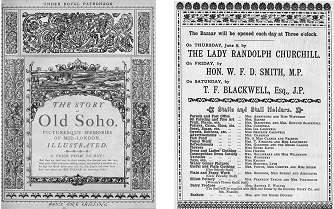 inish. The aristocracy had already departed by the middle of the 18th century and, with the subsequent neglect and lack of development, other respectable families gradually followed. In 1816-24, a rare act of the Crown was passed resulting in 700 properties being demolished to create Regent Street as a boundary between the upper classes of Mayfair and the residents of Soho. Composer Richard Wagner and his wife are known to have stayed in The Kings Arms at 23-25 Old Compton Street in 1839, and also at another establishment then called The Swiss Hotel at number 44, which was later to become known as The Swiss pub and where Harry Webb and his backing band made the decision to become Cliff Richard and The Drifters in 1958.
inish. The aristocracy had already departed by the middle of the 18th century and, with the subsequent neglect and lack of development, other respectable families gradually followed. In 1816-24, a rare act of the Crown was passed resulting in 700 properties being demolished to create Regent Street as a boundary between the upper classes of Mayfair and the residents of Soho. Composer Richard Wagner and his wife are known to have stayed in The Kings Arms at 23-25 Old Compton Street in 1839, and also at another establishment then called The Swiss Hotel at number 44, which was later to become known as The Swiss pub and where Harry Webb and his backing band made the decision to become Cliff Richard and The Drifters in 1958.
In 1854 there was an outbreak of cholera in Soho, caused by a spring that had become contaminated by sewage, that was tracked down to a public water pump at the junction of Broadwick Street (then called Broad Street) and Lexington Street (then called Cambridge Street ) by Dr. John Snow. The original pump has long gone, but a replica remains, a few yards away from the John Snow public house, named in his memory. By the middle of the 1800s the area had largely become populated by small theatres, music halls and, inevitably, prostitutes.
Soho has been at the centre of London’s ‘sex industry’ for well over 200 years. Between 1778 and 1801 the notorious ‘White House’, a “magical” brothel fitted out with various mechanical contraptions designed to terrify the unwary, was located at 21 Soho Square and, in more recent times, before the introduction of the 1959 Street Offences Act, prostitutes packed the streets and alleys.
B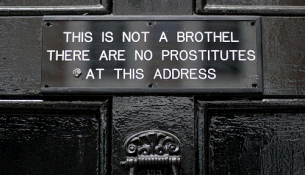 y the early Sixties there were nearly 100 strip clubs and the area was inundated with stickers and postcards (known as ‘walk-ups’) advertising ‘French Lessons’ or similarly ambiguous services. The early Sixties also saw the introduction of a number of ‘sex shops’, initially by Carl Slack, which had expanded to just under 60 locations in Soho alone, by the mid-Seventies. A photographic studio at number 4 Gerrard Street was occupied by ‘glamour photographer’ and ‘girlie magazine’ publisher Harrison Marks, who was responsible for such publications as ‘Kamera’ until he broke up with partner and ‘model’ Pamela Green in 1967.
y the early Sixties there were nearly 100 strip clubs and the area was inundated with stickers and postcards (known as ‘walk-ups’) advertising ‘French Lessons’ or similarly ambiguous services. The early Sixties also saw the introduction of a number of ‘sex shops’, initially by Carl Slack, which had expanded to just under 60 locations in Soho alone, by the mid-Seventies. A photographic studio at number 4 Gerrard Street was occupied by ‘glamour photographer’ and ‘girlie magazine’ publisher Harrison Marks, who was responsible for such publications as ‘Kamera’ until he broke up with partner and ‘model’ Pamela Green in 1967.
Gerrard Street is the main thoroughfare of ‘Chinatown’ and is named after Baron Gerard of Brandon, Suffolk, who commissioned the development of the land in 1680. It first saw an influx of Chinese residents in the 1920s, but did not become a significant ‘Chinese’ area until after WWII when the oriental population was expanded by the many refugees from other heavily-bombed parts of London.
By the start of the 20th century, with the further influx of immigrants who ran cheap eating establishments, the area continued to enhance its Bohemian reputation and increasingly became ‘the’ fashionable meeting place for artists, actors, writers and intellectuals. This, in turn, provided the essential basic clientele for the opening and growth of many more drinking houses and it was during this period that local pub landlords firmly established themselves in the area. Lyons specialised in large-scale catering and the three Corner Houses in Soho seated 9,000 people, and handled up to 15 sittings (135,000 customers) a day!
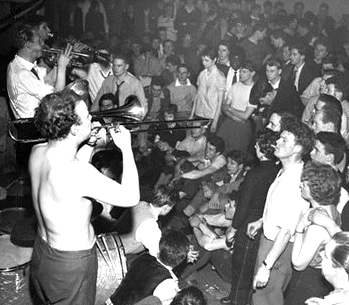 The development of its music scene, for which the area and name are now world famous, is generally considered to have evolved from just after the second World War at Club Eleven, a nightclub situated at 41 Great Windmill Street , that is now looked upon as the genesis of modern jazz music in Britain. Although it only had a two year lifespan between 1948 and 1950 it was significant in the development of a form of modern jazz known as bebop. It had two ‘house’ bands – one led by Ronnie Scott which included Lennie Bush, Hank Shaw, Tony Crombie and Tommy Pollard – the other led by Johnny Dankworth which included Bernie Fenton, Laurie Morgan, Leon Calvert and Joe Muddell. These 10 musicians, together with business manager Harry Morris, gave the establishment its name – Club Eleven. The club moved to 50 Carnaby Street in 1950 but closed down a few months later as a result of a police raid. Other notable local music establishments of the period were The Daybreak Club at 44 Gerrard Street, The 51 Club in Great Newport Street and The Harmony Inn, which was a seedy, ‘open all hours’ cafe on Archer Street that provided a late-night hang-out for musicians and music fans from the nearby Cy Laurie’s Blue Heaven Club (in Ham Yard, on the site of The Ham Bone club, which originally opened in the 1920s and became Cy Laurie’s Skiffle Club in the Fifties, but was best known for its jazz music). London’s first skiffle club ‘The London Skiffle Centre’ was opened in 1952 on the first floor in The Roundhouse pub, Wardour Street, by blues guitarists Bob Watson and Cyril Davies.
The development of its music scene, for which the area and name are now world famous, is generally considered to have evolved from just after the second World War at Club Eleven, a nightclub situated at 41 Great Windmill Street , that is now looked upon as the genesis of modern jazz music in Britain. Although it only had a two year lifespan between 1948 and 1950 it was significant in the development of a form of modern jazz known as bebop. It had two ‘house’ bands – one led by Ronnie Scott which included Lennie Bush, Hank Shaw, Tony Crombie and Tommy Pollard – the other led by Johnny Dankworth which included Bernie Fenton, Laurie Morgan, Leon Calvert and Joe Muddell. These 10 musicians, together with business manager Harry Morris, gave the establishment its name – Club Eleven. The club moved to 50 Carnaby Street in 1950 but closed down a few months later as a result of a police raid. Other notable local music establishments of the period were The Daybreak Club at 44 Gerrard Street, The 51 Club in Great Newport Street and The Harmony Inn, which was a seedy, ‘open all hours’ cafe on Archer Street that provided a late-night hang-out for musicians and music fans from the nearby Cy Laurie’s Blue Heaven Club (in Ham Yard, on the site of The Ham Bone club, which originally opened in the 1920s and became Cy Laurie’s Skiffle Club in the Fifties, but was best known for its jazz music). London’s first skiffle club ‘The London Skiffle Centre’ was opened in 1952 on the first floor in The Roundhouse pub, Wardour Street, by blues guitarists Bob Watson and Cyril Davies.
The basement premises of Studio 51 (originally just known as ‘The Studio’) in Great Newport Street were owned by Vi Highland. During 1950-51 various jazz ‘clubs’ were held on different nights featuring artists such as Johnny Dankworth, Joe Muddel, The Crane River Jazz Band and Chris Barber (‘Lincoln Fields’). From May 1951 five nights of the week were earmarked for modern jazz, and these were named ‘Studio 51’, under Joe Muddel’s musical direction. When Ken Colyer returned from his New Orleans trip in 1954 a ‘club’ with his name started on Monday nights and, by 1955, it was also host to the Johnny Dankworth ‘club’ and a band led by Harry Klein. Ken Colyer’s single ‘club’ night expanded to four with the increase in popularity of trad jazz and modern jazz was largely dropped, with the venue then being known better as The Ken Colyer Club rather than Studio 51. The 1960s saw rhythm and blues taking over from trad jazz with Arthur ‘Big Boy’ Crudup, The Yardbirds and John Mayall performing there, as well as The Rolling Stones who had a residency there in 1963, although The Ken Colyer ‘club’ continued until the late 1960s.Although thought of as a comparatively modern thing, the influx of Italian immigrants saw Bar Italia being opened at 22 Frith Street, in 1949, by Lou and Caterina Polledri. It still opens 22 hours a day, is home to a Mod scooter club that meets every Sunday at 6pm and has an original 1950s Gaggia coffee machine. There was a ‘renaissance’ of coffee houses in the Fifties, but it really exploded when Gina Lollobrigida officially ‘opened’ the Moka coffee bar at 29 Frith Street in 1953, which boasted London’s first Gaggia expresso machine. Achille Gaggia had patented the espresso machine in 1938, a machine that applied steam pressure to ground coffee, extracting its flavour to create a rich, creamy foam layer. An improvement ten years later incorporated a spring that applied additional pressure, allowing the production of a short black espresso in just fifteen seconds.
Italian-style espresso bars sprang up everywhere, almost overnight, initially in Soho but rapidly spreading across the capital and the country, sparking a revival in the popularity of the drink among the younger generation who were precluded from alcohol-serving establishments. The Moka was a huge success, selling over a thousand cups of coffee a day and it survived until 1972 when it closed under strange circumstances. Beat legend William S. Burroughs was not impressed by The Moka and believed it to be responsible for an ‘outrageous and unprovoked discourtesy and poisonous cheesecake’. He decided to mount a sound-and-vision attack, as he had previously successfully done against the Church of Scientology at 37 Fitzroy Street. He maintained that ‘as soon as you start recording situations and playing them back on the street, you create a new reality’ and that constant exposure to such attacks would lead to ‘accidents, fires and removals’. He stood outside The Moka every day, taking photographs and making tape recordings, returning the next day to play the previous day’s recordings. On October 30th 1972, the Moka Bar closed.
Ma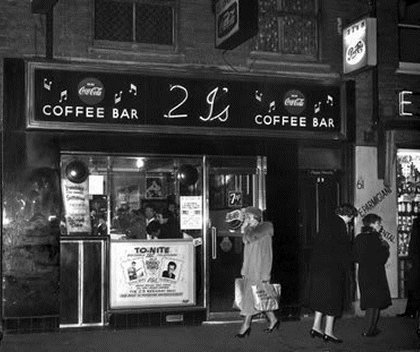 ny of the new espresso bars attracted the clientele of the local youth by featuring the live music for which the area was already famous, including the ‘Heaven and Hell’ in Old Compton Street and the ‘Top Ten’ in Berwick Street but the most famous of these was undoubtedly the 2i’s, in the basement of 59 Old Compton Street, which was previously a steak bar, bought and opened in its new form in 1956 by ‘Doctor Death’ – a famous masked wrestler and wrestling promoter of the time called Paul Lincoln. The establishment’s name is believed to relate to two brothers who were previous owners. The 2i’s also featured live music and was a popular venue for artists and acts hoping to be ‘discovered’.
ny of the new espresso bars attracted the clientele of the local youth by featuring the live music for which the area was already famous, including the ‘Heaven and Hell’ in Old Compton Street and the ‘Top Ten’ in Berwick Street but the most famous of these was undoubtedly the 2i’s, in the basement of 59 Old Compton Street, which was previously a steak bar, bought and opened in its new form in 1956 by ‘Doctor Death’ – a famous masked wrestler and wrestling promoter of the time called Paul Lincoln. The establishment’s name is believed to relate to two brothers who were previous owners. The 2i’s also featured live music and was a popular venue for artists and acts hoping to be ‘discovered’.
Some of the future stars who performed there were Cliff Richard, Hank Marvin, Jet Harris, Tony Meehan, Brian Bennett, Brian ‘Licorice’ Locking, The Vipers, Tommy Steele, Russ Sainty, Tony Sheridan, Rory Blackwell, Joe Brown, Clem Cattini, Screaming Lord Sutch, Mickie Most (as The Most Brothers), Paul Gadd (who became Paul Raven and later Gary Glitter), Johnny Kidd, Big Jim Sullivan, Terry Dene, Carlo Little, Richie Blackmore, Alex Wharton, Jay Chance, Wee Willie Harris and Eden Kane. Peter Grant was employed there as a ‘bouncer’ prior to his career as the manager of Led Zeppelin and Marc Bolan worked there as a waiter. The bar was featured in Cliff Richard’s second film, ‘Expresso Bongo’, made in 1959.
Subsequent to the success of the original 2i’s, the owners established a new venue at 44 Gerrard Street, initially known as the new 2i’s but which was later to become ‘Happening 44’ where Fairport Convention played some of their first gigs. The various establishments all found their niche in the society of the area and tended to attract their own specific clientele from the various ‘cultures prevalent in the area including the Edwardian ‘teddy boys’, the bohemians and, slightly later, the homosexual community who found the bars less threatening and more sociable than the strongly heterosexual clubs and other locations than they had previously had to use for furtive liaisons and gatherings.
Prior to 1957, The Wolfenden Report and a police crackdown on homosexual meeting places, basement and attic bars in venues such as Take 5, The Casino, No.9,The Huntsman and The Alibi had been favourite haunts until frequent police ‘raids’ drove them underground.
Also prevalent in the Fifties was the Beatnik culture, whose followers steeped themselves in beat poetry, jazz, jive dance and political debate and who also favoured the newly-introduced establishments such as Chas McDevitt’s ‘Freight Train’, The Stockpot, La Roca, Melbray, Le Grande, Universal, El Toro, Las Vegas, Le Grande, Sam Widges, Melbray, The French, The Picasso and Le Macabre in Wardour Street with its coffin-shaped tables.
The owner of Le Macabre (and also the New Yorker restaurant), Tony Mitchell, went on to buy premises in SW7 at 3, Cromwell Road and created The Cromwellian Club, soon to be joined in the business by professional wrestlers Judo Al Hayes ‘The White Angel’, Bob (Anthony) Archer nicknamed the ‘Wrestling Beatle’, ‘Rebel’ Ray Hunter and Paul Lincoln, aka ‘Doctor Death’, who owned Soho’s 2is coffee bar.
In bars like the 2i’s that featured live music, fees for appearing were a rarity, performers usually being recompensed with free coffee and Coca Cola, as they also were in another nearby establishment, The Cat’s Whisker, which was owned by Peter Evans who went on to found the Angus Steak House chain. Another fondly-remembered hang-out was the ‘Coffee Ann’ that catered almost exclusively for the music club-goers. Situated down some steep steps in the basement of a warehouse in Whitcombe Street, it was known for staying open into the early hours of the morning but was rarely, if ever, open during the day. ‘Les Enfants Terrible’ at 93 Dean Street was another expresso café venue that featured live music and was mainly frequented by many French students.
H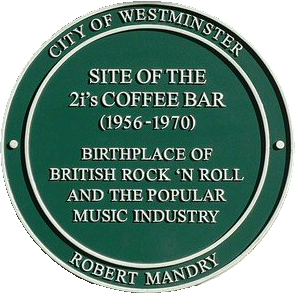 owever, the coffee bars are most strongly remembered and identified as being the focal point for young people ( now becoming generally identified as ‘teenagers’), embracing the new musical sounds being imported into the city’s culture. This came about due, in equal parts to the ‘fashionable’ drinking of Italian coffee, the bright and modern furnishings, the provision of the exciting new music that they loved and the fact that, unlike public houses, they were not subject to licensing laws meaning that anyone of any age could enter and the places could stay open all the hours that they wanted, serving non-alcoholic drinks such as coffee and cola.
owever, the coffee bars are most strongly remembered and identified as being the focal point for young people ( now becoming generally identified as ‘teenagers’), embracing the new musical sounds being imported into the city’s culture. This came about due, in equal parts to the ‘fashionable’ drinking of Italian coffee, the bright and modern furnishings, the provision of the exciting new music that they loved and the fact that, unlike public houses, they were not subject to licensing laws meaning that anyone of any age could enter and the places could stay open all the hours that they wanted, serving non-alcoholic drinks such as coffee and cola.
There was also the added attraction of a greater female presence due to the less threatening and ‘public’ nature of the coffee bars compared to the male-dominated pubs and clubs. In January 1966, towards the end of the ‘coffee bar’ era, ‘The Goings On’ was opened in Archer Street organised by a group of Liverpool beat poets including Johnny Byrne, Spike Hawkins and Pete Brown. The bar happily functioned as a sort of ‘beat club’ on Saturday afternoons, spending the rest of the week operating as an illegal gambling establishment.
Places known as ‘clip joints’ also started to appear in the early Sixties, swindling tourists who were looking for ‘a good time’ by selling them low quality liquids as ‘champagne’, at vastly inflated prices, with the unfulfilled promise of the services of the female ‘hostesses’. The Compton Cinema Club, a ‘private member’ establishment to circumvent the law, opened at 56 Old Compton Street in 1960, becoming the capital’s first sex cinema.
The owners were Tony Tenser and Michael Klinger, who produced some of the early Roman Polanski films such as ‘Cul-de-sac’ and who also owned the premises that had previously been a Beatnik club, turning it into the ‘Heaven and Hell’ hostess club, just across the road from the 2i’s coffee bar on the corner of Dean Street and Old Compton Street.
Muriel Belcher, ‘a theatrical Portuguese Jewish lesbian of Welsh extraction’, was the founder and proprietor of a private drinking club called ‘The Colony Room’ (also known as Muriel’s) upstairs at 41 Dean Street in 1948 (next to The Groucho Club), having previously run a club called ‘The Music Box’ in Leicester Square during WWII. Although public houses had to close at 2:30pm, she managed to acquire a 3pm-11pm drinking licence for The Colony Room bar as a ‘private members’ club. The club had some notoriety, not only for its clientele and its sickly green décor (a bright green room decorated with bamboo, mottled mirrors, leopard-skin barstools and plastic tropical plants), but also for the personality and sexuality of the owner herself – she attracted many gay men to the club as well as those brought there by her Jamaican girlfriend, Carmel.
George Melly said of her, “Muriel was a benevolent witch, who managed to draw in all London’s talent up those filthy stairs. She was like a great cook, working with the ingredients of people and drink. And she loved money”. Belcher was famous for her rudeness, a trait which became part of the club’s ‘culture’. Members included George Melly, Francis Bacon, Peter O’Toole, Dylan Thomas, Louis MacNeice, Charles Laughton, E.M. Forster, Lucian Freud, Frank Auerbach, Tallulah Bankhead, Mary Kenny, Lady Rose McLaren and John Hurt. On her death in 1979 it was taken over by her long-term barman, Ian Board (known as ‘Ida’) until his death in 1994, then by veteran barman Michael Wojas, and Dick Bradsell until its closure. It was popular with artistic types, particularly those known as ‘Young British Artists’, (YBAs), who included Damien Hirst, Sarah Lucas and Tracey Emin.
D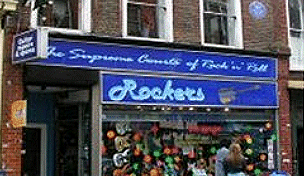 enmark Street first appears on land surveys dating from the 1730s situated in an area known locally as ‘The Rookery’ which was basically an unplanned slum that was mostly cleared and redeveloped by the end of the 1800s. It is one of the very few roads in London that still has original 17th century terraced facades on both sides. It is a short and narrow road with St. Giles High Street to the east and Charing Cross Road to the west, particularly renowned for its connections with British pop music, and is generally regarded as the British ‘Tin Pan Alley’.
enmark Street first appears on land surveys dating from the 1730s situated in an area known locally as ‘The Rookery’ which was basically an unplanned slum that was mostly cleared and redeveloped by the end of the 1800s. It is one of the very few roads in London that still has original 17th century terraced facades on both sides. It is a short and narrow road with St. Giles High Street to the east and Charing Cross Road to the west, particularly renowned for its connections with British pop music, and is generally regarded as the British ‘Tin Pan Alley’.
The industry connections are many and not just limited to its large number of instrument-selling and music-related establishments. Melody Maker was first published there in 1926 and The New Musical Express was founded on, and published its first British music chart from, the first floor of number 5 in 1952.
Denmark Street was the place to be for songwriters and music publishers during the Fifties and early Sixties and it was in the bars and cafes around the area that a young writer named Lionel Bart , more famous for his musical show scores, listened to the R&B sounds brought back from America by merchant sailors, inspiring him to write some of the first British rock’n’roll music, mainly for Larry Parnes‘ artists. In the early days his co-writers included Tommy Hicks (Tommy Steele) and Mike Pratt (actor probably best known as the ‘alive’ partner in the TV series ‘Randall & Hopkirk – Deceased’).
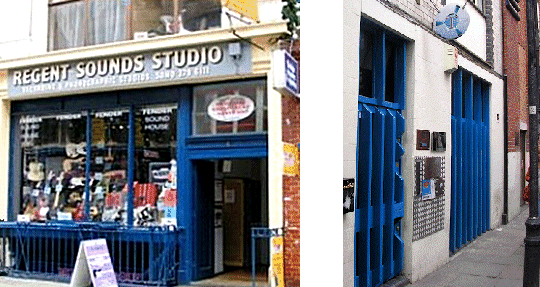 The Regent Sounds Studio opened at number 4 Denmark Street in 1963, one of the first in the area, and The Rolling Stones recorded their first album there in 1964. Jimi Hendrix and Stevie Wonder also recorded there, as did the ‘British Bob Dylan’, Donovan, and it was one of the first studios to install a 16-track sound recorder. David Bowie allegedly couldn’t afford a flat here and chose to live in the street in a camper to be closer to the studios and, slightly more recently, The Sex Pistols lived and recorded their first demo tracks above number 6. The Beatles’ George Harrison is said to have purchased an acoustic guitar in Denmark Street which was used on the track ‘Til There Was You’ on their second album ‘With The Beatles’ and Elton John is supposed to have written ‘Your Song’ there. Denmark Street was also the ‘birthplace’ of the SciFi comic empire, ‘Forbidden Planet’.
The Regent Sounds Studio opened at number 4 Denmark Street in 1963, one of the first in the area, and The Rolling Stones recorded their first album there in 1964. Jimi Hendrix and Stevie Wonder also recorded there, as did the ‘British Bob Dylan’, Donovan, and it was one of the first studios to install a 16-track sound recorder. David Bowie allegedly couldn’t afford a flat here and chose to live in the street in a camper to be closer to the studios and, slightly more recently, The Sex Pistols lived and recorded their first demo tracks above number 6. The Beatles’ George Harrison is said to have purchased an acoustic guitar in Denmark Street which was used on the track ‘Til There Was You’ on their second album ‘With The Beatles’ and Elton John is supposed to have written ‘Your Song’ there. Denmark Street was also the ‘birthplace’ of the SciFi comic empire, ‘Forbidden Planet’.
Between Wardour Street and Dean Street there is a connecting alley called St.Anne’s Court where The Blue Gardenia Club existed for a short while at number 20 during the early Sixties. Managed by Brian Casser (Cass, of Cass and The Cassanovas) whose claim to fame is allegedly being the first venue in London where The Beatles ever performed, on the 9th (or possibly 10th) December 1961. This was apparently an impromptu set played by Paul and John, with Pete Best on drums, while George (who had the ‘flu) chatted with one of the clientele.
Almost next door, at number 17, is Trident Recording Studios, the first in the UK to install 8-track recording and where The Beatles recorded ‘Hey Jude’, four of the tracks for ‘The White Album’ and ‘I Want You’ from ‘Abbey Road’. Ringo Starr’s ‘Sentimental Journey’ album, George Harrison’s ‘My Sweet Lord’ and much of his ‘All Things Must Pass’ triple album were also recorded here as was Paul McCartney’s production of Mary Hopkin’s ‘Those Were The Days’. On the edge of Soho, situated at 31 Whitfield Street (Fitzrovia) was the CBS ‘Hit Factory’ where, in December 1966, The Jimi Hendrix Experience recorded their first album ‘Are You Experienced’. The Clash also recorded their first album there in 1977.
The number of live music establishments increased considerably during the Fifties, taking advantage of the new sounds arriving from America and the emergence of modern British music talent alongside the already established jazz and R&B establishments. This, inevitably, attracted the younger generation who had more money than ever before and were eager to break away from the grey days of post-war society.
From this melting pot came the Modernists, or ‘Mods’, embracing the new music and evolving their own hairstyles, fashions and culture, and who were to ‘adopt’ certain of these new music establishments as the ‘in’ places to be, although pretty well all the clubs had a Mod clientele to a greater or lesser extent. The best-known of these were The Flamingo, La Discotheque, The Scene and The Marquee Club.
The Flamingo Club (which also incorporated weekend late-opening sessions known as the ‘AllNighter’) was located at 33-37 Wardour Street and evolved from Jeffrey Kruger’s ‘Jazz at the Mapleton’ which began life in August 1952 at The Mapleton restaurant in Coventry Street, moving to Wardour Street in 1957. Jeffrey Kruger was to become a major music promoter, later forming Ember Records and the TKO Group. During its early life the club featured a resident band containing the likes of Ronnie Scott, Tony Crombie, Tommy Pollard and Joe Harriott and attracted notable live performers such as Billie Holliday, Ella Fitzgerald and Sarah Vaughan. In 1959 it was re-launched as The Flamingo Club where, in 1962, it was the venue at which the infamous fight between Aloysius ‘Lucky’ Gordon and Johnny Edgecombe over a girl named Christine Keeler occurred, a link in the chain of events that was to explode into British political history as ‘The Profumo Affair’.
The Flamingo was a ‘jazz’ club until midnight on Fridays and Saturdays, when the ‘AllNighter Club’ club kicked in, which would remain open until about 6a.m. Although the establishment was known to be one of the main centres of Mod culture, it was frequented by fans of both jazz and R&B, from many ethnic groups, and it is generally accepted that it helped significantly in breaking down the old post-WWII racial prejudices in the area. Specialising in the R&B sounds loved by the Mods, The Flamingo probably had the dearest entrance fee, £1-10shillings (£1.50 – about £24 in today’s money) because of the top acts it featured.
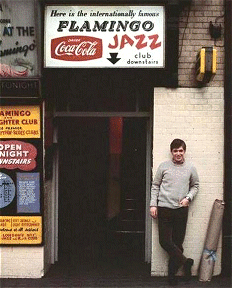 Regularly appearing at the venue were Georgie Fame and The Blue Flames (who released a full LP titled ‘Rhythm & Blues at The Flamingo’ in 1964), Chris Farlowe and The Thunderbirds, Zoot Money’s Big Roll Band, Geno Washington and the Ram Jam Band and Shotgun Express, who featured an artist called Rod Stewart. Members of other major groups of the time such as The Beatles, The Rolling Stones and Jimi Hendrix were all regular visitors. In the mid-Sixties the club attracted many major artists from the other side of the Atlantic such as Jerry Lee Lewis, Bill Haley and His Comets, Stevie Wonder and John Lee Hooker.
Regularly appearing at the venue were Georgie Fame and The Blue Flames (who released a full LP titled ‘Rhythm & Blues at The Flamingo’ in 1964), Chris Farlowe and The Thunderbirds, Zoot Money’s Big Roll Band, Geno Washington and the Ram Jam Band and Shotgun Express, who featured an artist called Rod Stewart. Members of other major groups of the time such as The Beatles, The Rolling Stones and Jimi Hendrix were all regular visitors. In the mid-Sixties the club attracted many major artists from the other side of the Atlantic such as Jerry Lee Lewis, Bill Haley and His Comets, Stevie Wonder and John Lee Hooker.
The club was renamed The Pink Flamingo (aka The Flamingo at The Temple) in the mid-late Sixties and finally closed its doors a couple of years later. Also located at 33-37 Wardour Street, on the upper floor of the same premises, was another live music establishment, the Whiskey A-Go-Go where, in March 1958, Buddy Holly gave a press conference prior to his 25-date tour of the UK. Although arguably less popular than The Flamingo, it had a certain ‘chic’ as it was one of the few clubs that was licensed to sell alcohol and survived until 1981 when it changed its name to The Wag Club, enjoying something of a revival for a time. In 1996, in a strange ‘full circle’, it was boosted by the introduction of the Sixties-inspired ‘Blow-Up’ sessions, finally closing its doors in 2001. The location is now in use as one of the O’Neill’s Irish theme pub chain.
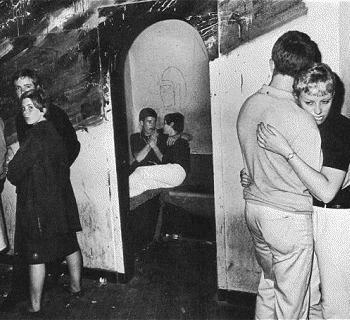 With its entrance situated in Ham Yard, off Great Windmill Street just behind Piccadilly Circus, The Scene club (formerly The Piccadilly Club) had previously been a jazz club featuring both records and live acts that had, by 1963, been ‘adopted’ by the Mods. To accommodate its ‘new’ clientele it was remodelled and re-opened in March 1963 with DJ Guy Stevens spinning the latest records from America via a Duke Vin sound system. Guy was also one of the originators of the Chuck Berry Appreciation Society, instrumental in bringing Chuck Berry to Britain for his first UK tour.
With its entrance situated in Ham Yard, off Great Windmill Street just behind Piccadilly Circus, The Scene club (formerly The Piccadilly Club) had previously been a jazz club featuring both records and live acts that had, by 1963, been ‘adopted’ by the Mods. To accommodate its ‘new’ clientele it was remodelled and re-opened in March 1963 with DJ Guy Stevens spinning the latest records from America via a Duke Vin sound system. Guy was also one of the originators of the Chuck Berry Appreciation Society, instrumental in bringing Chuck Berry to Britain for his first UK tour.
In 1964 the man who ‘discovered’ Millie Small and turned her into a pop star with ‘My Boy Lollipop’, Chris Blackwell, employed Stevens to run his Sue Record Label company. After serving a jail sentence for drug possession in 1966 Stevens was to go on to produce Procol Harum (named after Stevens’ cat!), Free, Mott The Hoople and the ‘London Calling’ album for The Clash. Live entertainment was provided by a number of ‘house’ bands including Zoot Money, Graham Bond, Georgie Fame and, on occasion, The Animals, who appeared as part of what was something like a ‘work exchange’ scheme of the time. Such was its reputation as the Mods ‘HQ’ that all the ‘faces’ congregated here and it was visited on a regular basis by representatives of the TV music show ”Ready Steady Go” to choose audience members and dancers to appear in the ‘live’ shows to exhibit the latest fashion trends and demonstrate new dances.
Set in a basement, the main décor was matt black with red toilet walls. Membership of the club was 1 guinea, (21 shillings or £1.05 – about £17 today) after which there was also an entry fee which apparently varied according to the entertainment available. As with some other clubs such as the Whisky-A-Go-Go, Tuesday nights were free to members, other nights were about 1 shilling (5p) except the ‘all-nighter’ on Saturdays (a favourite night for police drug raids) which would set you back 5 shillings (25p – about £4 today). Hands were stamped and once down the stairs and through the ‘bat wing’ doors, you were in a surprisingly small, low-ceilinged area, dimly-lit with blue fluorescents. There was a non-alcoholic bar, the DJ’s area, an undersized stage area with a ‘baby grand’ piano and a number of ‘booths’ with tables along the far wall, the rest of the area being occupied by the dance floor. The club was managed by an entrepreneurial Irishman called Ronan O’Rahilly who also managed several of the acts, including Graham Bond and Georgie Fame, and owned his own independent record label.
The music industry of the time was something of a cartel that was monopolised by the big labels such as Pye, Decca, Philips and Columbia records, as Ronan discovered when he tried to get a Georgie Fame recording played on the BBC and Radio Luxembourg. The situation was, to him, completely unacceptable and he found a unique way around it by setting up the pirate radio station Radio Caroline off the coast of Essex in international waters. The Scene lasted until 1966 when the Mod era started to dissipate and I believe it became the King Creole club for a time until it finally closed down. Sixties City Pirate Radio History
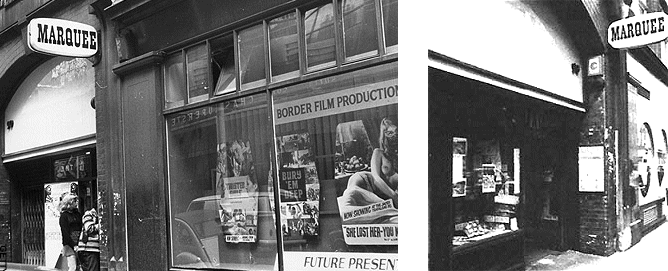
Also in Wardour Street was the legendary Marquee Club. Originally opened on April 19th 1958 as a jazz, skiffle and blues club located at 165 Oxford Street, featuring acts such as Alexis Korner’s Blues Incorporated and was the venue where, on 12th July 1962, The Rolling Stones played their first live gig.
It relocated to smaller premises in an old Burberry warehouse at 90 Wardour Street in the spring of 1964 when its opening night acts included Sonny Boy Williamson and The Yardbirds. Although not an ‘essential’ Mod club, with its staple R&B and Blues music, it still attracted many now-famous acts, such as Manfred Mann, The Who, The Spencer Davis Group, John Mayall’s Bluesbreakers, Rod Stewart, Eric Clapton and The Yardbirds, The Moody Blues and Long John Baldry.
In late 1966 it staged the Sunday afternoon ‘Spontaneous Underground happenings’ that featured the latest in ‘psychedelic rock’ music, including a young Pink Floyd, led by Syd Barrett.
It also hosted Led Zeppelin, King Crimson and The Jimi Hendrix Experience. The Moody Blues hit ‘Go Now’ was recorded by Alex Murray, their manager, in a homemade studio in a garage at the back of the club and also produced the UK’s first ‘pop’ promotional video. It is said that the Marquee Studios were largely financed from the profits of this one record.
The club relocated to Charing Cross Road in 1988 when it was believed that the vibrations from the sound system had caused damage to the structure of the building’s façade. Although the original entrance remains, known as Soho Lofts apartments, the main club area was demolished and replaced with a Terence Conran restaurant.
Just a few doors down from The Flamingo, at number 17 Wardour Street, was La Discotheque which was a little different in that it did not feature live acts but established itself as London’s first real ‘disco’. In the mid-Fifties the notorious Notting Hill slum landlord Peter Rachman decided to expand his ’empire’, building up a chain of gambling clubs and, in 1956, opened the El Condor club under the management of Raymond Nash, one of the Lebanese gangster family. The El Condor was one of ‘the’ places to be in the late Fifties and boasted a clientele that included royals such as the Duke of Kent and Princess Margaret. It was re-launched as La Discotheque in the early Sixties, featuring curious Bohemian décor, including toilets and bedsteads. This was also to have a connection with the Profumo Affair due to Rachman’s involvement with Mandy Rice-Davies who, with dark hair, can be seen with Rachman in photographs of the club’s opening night, and who was to famously throw a drink in the face of one of the Kray brothers in an incident at the club.
In Carnabv Street, before the Mod fashion boutique ‘boom’ when the narrow side street consisted of a brick warehouse along one side and contained only a few clothes shops and a newsagents, was The Sunset Club – home to jazz and Caribbean music which played until seven in the morning. It provided a place for musicians to get together when their own clubs closed for the night and was, racially, totally mixed, there being no such thing as a purely black clientèle at that time. Under the ownership of a larger-than-life character called Count Suckle ( real name Wilbert Augustus Campbell) it became ‘The Roaring Twenties.
The Count had come to the UK in 1952 as one of the ‘Windrush’ generation, along with the celebrated Jamaican DJ Duke Vin, who is credited with setting up the first hi-fi sound system in the UK and who provided sound systems for several local establishments. Charles Brown, (who was the Jamaican landlord of murderer John Christie at 10 Rillington Place) was the doorman at the Sunset club. Count Suckle also owned The Cue (later ‘Q’) Club in Praed Street, Paddington, and was later to start his own record label, Q Records (a subsidiary of Trojan Records). The sounds consisted largely of Ska/Blu Beat (later known as reggae) and the music of the likes of The Kingsmen, Doris Troy, Etta James and Otis Redding, both as a disco and with live performances. Georgie Fame also appeared here.
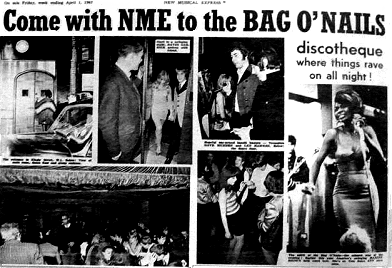 Another club in close proximity to Carnaby Street was the ‘Bag O’Nails’, affectionately known as ‘The Bag’, at 8/9 Kingly Street, opened by Rik and John Gunnell (in November 1966) who were already part of the local club scene. In the heart of the Sixties fashion and music world it was an important part of the ‘Swinging Sixties’ society. Using the DJ’s booth, The Jimi Hendrix Experience played their first UK gig there in December 1966 and the internals of the establishment have changed little to the current day. The club was a popular celebrity venue, somewhat more ‘up market’ than other venues in that it provided food and drink as well as live music.
Another club in close proximity to Carnaby Street was the ‘Bag O’Nails’, affectionately known as ‘The Bag’, at 8/9 Kingly Street, opened by Rik and John Gunnell (in November 1966) who were already part of the local club scene. In the heart of the Sixties fashion and music world it was an important part of the ‘Swinging Sixties’ society. Using the DJ’s booth, The Jimi Hendrix Experience played their first UK gig there in December 1966 and the internals of the establishment have changed little to the current day. The club was a popular celebrity venue, somewhat more ‘up market’ than other venues in that it provided food and drink as well as live music.
Apart from the many celebrities who frequented it – almost a ‘who’s who’ of British Sixties music, it is also known as being the meeting place of Linda Eastman and Paul McCartney at a Georgie Fame gig on 15th May 1967. Paul recalled “I saw this blonde across the room and I fancied her. So when she passed my table I said something stupid like Hello, how are you? Let me take you away from all this”. Linda commented ” It was like a cartoon. It sounds silly, but our eyes met and something just clicked”. Also said to have met here for the first time were the (later) Fleetwood Mac members John and Christine McVie. On the other side of the coin, it is alleged that Elton John spent an evening drinking here in 1968 with Bernie Taupin and Long John Baldry who spent the entire time talking him out of his upcoming marriage at which Baldry was going to be best man.
C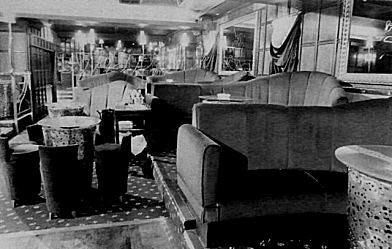 arl Douglas & The Big Stampede had a 14-night residency during the opening fortnight. Band member Tony Webb “We’d been playing at the Bag O’ Nails the night before and had left the gear there. When we went in [the next day] all of our gear was off the stage to one side. We didn’t know it at the time but this guy who we now know was [Jimi] Hendrix and his three-piece band was playing onstage with photographers. We were more annoyed that our gear had been taken off the stage!”
arl Douglas & The Big Stampede had a 14-night residency during the opening fortnight. Band member Tony Webb “We’d been playing at the Bag O’ Nails the night before and had left the gear there. When we went in [the next day] all of our gear was off the stage to one side. We didn’t know it at the time but this guy who we now know was [Jimi] Hendrix and his three-piece band was playing onstage with photographers. We were more annoyed that our gear had been taken off the stage!”
Also nearby, 4 Kingly Court housed The Pinstripe Club which was frequented by celebrities such as Oliver Reed, Steve McQueen, George Best, Richard Harris, Audrey Hepburn and Marilyn Monroe. It closed down as a result of the 1963 scandal where John Profumo was forced to resign as Secretary of State for war over allegations regarding an affair with Christine Keeler, the mistress of a Russian spy, at the height of the Cold War. The same general clientele returned when it re-opened as The Kingly Club, becoming known as ‘the haunt of the rich and infamous’.
Geoffrey Worthington and ex-policeman William Bryant opened a club, similar in concept to The Scene but essentially aimed at the homosexual community, in a basement in D’Arblay Street in 1964, called Le Duce, following a failed attempt to operate a discreet bar called The Lounge in Whitehall. The new establishment stayed open all night on Saturdays, favouring mainly Motown and Blue Beat music, and had a vigorous entry policy that was, by all accounts, fairly successful in keeping out undesirable and disruptive elements.
Mods aside, there were a number of jazz clubs in the area, by far the most famous of which is Ronnie Scott’s. It originally opened on 30th October 1959 in the basement of 39 Gerrard Street, moving to its present, larger location at 47 Frith Street in 1965. The original club continued to exist, known as ‘The Old Place’, as a ‘proving ground’ for new talent until its lease expired during 1967. Managed by musicians Ronnie Scott and Peter King, it was a live music establishment and the galaxy of stars who have appeared at the venue over the years are far too numerous to mention, as well as the number of performances ‘recorded live at Ronnie Scott’s’. Pete Townsend and The Who premiered their rock opera ‘Tommy’ at the club in 1969 and it is also famous for being the venue of Jimi Hendrix’s last live performance.
Following Scott’s death in December 1996, King ran the club for a further nine years until June 2005 when it was sold to theatre impresario Sally Greene.
Known as The Skiffle Cellar prior to the Sixties, Les Cousins (reputed to have taken its name from the 1959 Claude Chabrol film of the same name) was an innovative folk and blues club located in the basement of a restaurant at 49 Greek Street. Its décor included fishing nets and a large wagon wheel and it was extremely popular with more progressive artists in the field during the mid-60s folk music revival, with a number of live albums being recorded there. It is noted for having an influence on the careers of such musicians as Bert Jansch, Alexis Korner, Paul Simon, Al Stewart, Davey Graham, John Renbourn, John Martyn and Roy Harper.
Si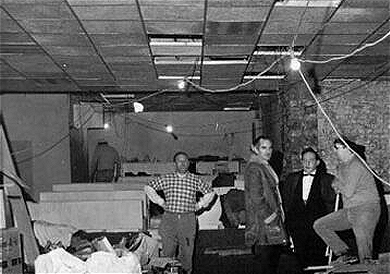 tuated at 100, Oxford Street, The 100 Club was originally called The Feldman Swing Club, becoming The London Jazz Club in 1948, The Humphrey Lyttelton Club in 1954, Jazz Shows Jazz Club and then, in the mid-60s, The 100 Club. The Ad Lib Club was located on the top floor of the Prince Charles Theatre at 7, Leicester Place, was a hang-out for the ‘beautiful people’ and is alleged to be the place where John Lennon and George Harrison shared their first LSD trip. Other clubs in the area included The Jack of Clubs in Brewer Street, The Alphabet Club in Gerrard Street which cost 10 shillings (50p – about £8 today) to get in, The St.Moritz Key Club in Wardour Street, Le Kilt, Club St.Germain and La Poubelle in Poland Street.
tuated at 100, Oxford Street, The 100 Club was originally called The Feldman Swing Club, becoming The London Jazz Club in 1948, The Humphrey Lyttelton Club in 1954, Jazz Shows Jazz Club and then, in the mid-60s, The 100 Club. The Ad Lib Club was located on the top floor of the Prince Charles Theatre at 7, Leicester Place, was a hang-out for the ‘beautiful people’ and is alleged to be the place where John Lennon and George Harrison shared their first LSD trip. Other clubs in the area included The Jack of Clubs in Brewer Street, The Alphabet Club in Gerrard Street which cost 10 shillings (50p – about £8 today) to get in, The St.Moritz Key Club in Wardour Street, Le Kilt, Club St.Germain and La Poubelle in Poland Street.
Opposite the 100 Club at number 79-89, was the short-lived Tiles Club (previously known as ‘Beat City’), which opened in March 1966 in a remarkable subterranean area. One of London’s best-kept secrets are the hidden and underground rivers and waterways that run through it.
One such river runs through the basement of Gray’s Antiques on South Molton and Davis Street and can be seen through a glass floor. It is thought that the river once ran across Oxford Street with a riverside roadway, due to there being a cobbled street with door arches and building frontages that apparently still exist in an area two floors below the ground.
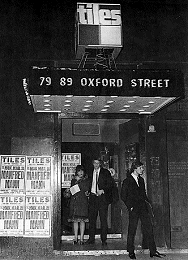 In the Sixties this was known as ‘Tiles Street’ and formed a part of the Tiles Club complex with late night shopping in the businesses that established themselves in this underground shopping arcade’. The club itself occupied a large open space with a coffee bar at one end and ‘Tiles Street’ was off to one side. The catacomb of small shops included a beauty parlour, a record shop and various clothes and accessory shops, including a boutique for women called ‘Plumage’.
In the Sixties this was known as ‘Tiles Street’ and formed a part of the Tiles Club complex with late night shopping in the businesses that established themselves in this underground shopping arcade’. The club itself occupied a large open space with a coffee bar at one end and ‘Tiles Street’ was off to one side. The catacomb of small shops included a beauty parlour, a record shop and various clothes and accessory shops, including a boutique for women called ‘Plumage’.
The club itself, unusually, was open at lunch times during the week, running an ‘all-nighter’ on Saturdays, and hosted an impressive number of live acts during its short existence, although it never gained the ‘cult’ status of the music establishments that had been in on the ‘ground floor’ of the culture change in the earlier years.
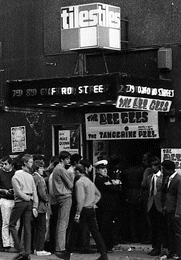 It had a superb, very reliable (but not hi-fi) PA system installed by Imhof’s, a record retailer in New Oxford Street, with speakers that ran all around the dance floor, which is not so surprising when you know that one of the club’s backers was a guy called Jim Marshall who owned the Marshall Amplifier company. The regular DJ was the ubiquitous Jeff Dexter, who was famous for disco gigs around the London clubs with his Jeff Dexter Record And Light Show.
It had a superb, very reliable (but not hi-fi) PA system installed by Imhof’s, a record retailer in New Oxford Street, with speakers that ran all around the dance floor, which is not so surprising when you know that one of the club’s backers was a guy called Jim Marshall who owned the Marshall Amplifier company. The regular DJ was the ubiquitous Jeff Dexter, who was famous for disco gigs around the London clubs with his Jeff Dexter Record And Light Show. 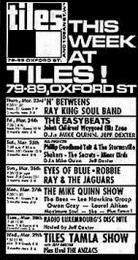
The club closed on Sunday 24th, 1967, unable to continue after the owners lost a fortune from their investment in an unsuccessful Woburn Abbey music festival, and the DJ presiding over their last night was John Peel. The site existed as an aquarium for a time during the Seventies that made way for redevelopment of the area in the Eighties.
Of course, the Sixties British cultural and music ‘boom’ went hand in hand with the revolution in fashion, and at the heart of it was a man called John Stephen and a run-down narrow lane in Soho, called Carnaby Street .
Leave a Reply